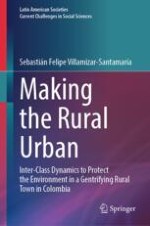2024 | OriginalPaper | Chapter
3. The Greening Class and Its Influence in La Calera
Author : Sebastián Felipe Villamizar-Santamaría
Published in: Making the Rural Urban
Publisher: Springer Nature Switzerland
Activate our intelligent search to find suitable subject content or patents.
Select sections of text to find matching patents with Artificial Intelligence. powered by
Select sections of text to find additional relevant content using AI-assisted search. powered by
